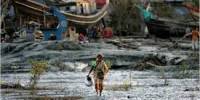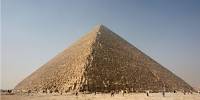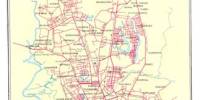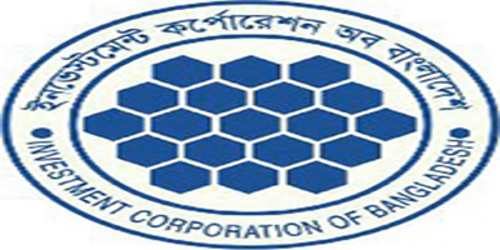Introduction:
A region of south central Asia, mainly mountainous but including the broad and fertile valleys of the river Indus and its majority tributaries. The territory is divided into two parts by the Himalayas. To the southeast are three region: the Vale of Kashmir or upper Jehlum valley, the districts of poonch and Mangla in the middle Jehlum valley and the Jummu-Kathua plain or the Chenab and Ravi valleys. Beyond the Himalayas, to the north and Northeast are Gilgit, Baltistan and Ladakh, the last two mainly occupied by the Karakoram ranges.
Historical Background:
Geologists believe that about ten crore years have passed when Kashmir Valley which was once a lake called Satisar, the lake of goddess Sati, came into its present form.
For hundreds of million years Kashmir Valley remained under Tethya sea andthe high sedimentary-rock hills seen in the valley now were once under water. Geologists have come to believe that Kashmir Valley was earlier affected by earthquakes. Once there was such a devastating earthquake that it broke open the mountain wall at Baramulla. And the water of the Satisar lake flowed out leaving behind lacustrine mud on the margins of the mountains known as karewas. Thus came into existance the oval but irregular Valley of Kashmir. The karewas being in fact the remanants of this lake confirm this view. The karewas are found mostly to the west of the river Jhelum where these table-lands attain a height of about 380 meters above the level of the Valley. These karewas protrude towards the east and look like tongue-shaped spurs with deep ravines.
Ancient legends and popular traditions say that Samdimat Nagar, capital of the kingdom of Sundra Sena, was submerged as a result of an earthquake, and the water that filled the area formed the Wular Lake, the largest fresh water lake in India. The oldest igneous rocks are still found at Shankaracharya hill. When the whole Valley of Kashmir was
under waterthis hillock was the first piece of dry land lying in the form of an igneous island.
Situation, Location, Area and Extent:
The territories of Jammu, Kashmir, Ladakh and Gilgit form the State of Jammu and Kashmir. The state of Jammu and Kashmir, which had earlier been under Hindu rulers and Muslim sultans, became part of the Mughal Empire under Akbar from 1586. After a period of Afgan rule from l756, it was annexed to the Sikh Kingdom of Punjab in 1819. In 1820 Maharaja Ranjit Singh made over the territory of Jammu to Gulab Singh. In 1846 Kashmir was also made over to Gulab Singh under the Treaty of Amritsar. Ladakh was annexed by Maharaja Gulab Singh in 1830. Thus this northernmost state was founded by Maharaja Gulab Singh in 1846 and was the biggest princely state in India before the partition of the country in August 1947. At that time the total area of the state was 2,22,236 sq. Km. Pakistan invaded the State in October 1947. Indian forces pushed Pakistan back but in 1949 when a cease fire line was drawn about one third of the area i.e. 78932 sq. Km. I.e. The whole of Gilgit, Mirpur, Kotli and a part of Poonch came into the possession of Pakistan, leaving behind only 143,30 sq. Km. On the Indian side. Jammu, Udhampur, Kathua and Anantnag districts remained unaffected. Again in 1962 China occupied about 64000 sq.kms. In Ladakh known as Aksai Chin. Pakistan again made an unlawful possession over Chhamb, Deva, Chakla and Manawar gaining an area of3999 sq. Kms. Thus total area left on the Indian side is about 12850 sq. Kms.
There are many low lying valleys in the state like Tawi Valley, Chenab Valley, Poonch Valley, Sind Valley and Liddar Valley, but the main Valley is the valley of Kashmir, which is 100 kms. Wide and 15520.3 sq. Kms. In area. Through this velley flows the river Jhelum with its tributaries. The height of the valley above sea level is about 1700 metres.
On the map of India, the State of Jammu and Kashmir looks like a crown. The state is 640 kms. In length from north to south and 480 kms. Form east to west. To its north lie Chinese and Russian Turkistan. On its east is Chinese Tibet. On the South and South-West lie the states of Punjab and Himachal Pradesh. On the west is the North West Frontier Provinces ofpakistan, China and Russia. Afghanistan and Pakistan now have come close to the boundaries of the state of Jammu and Kashmir, The nearness to the boundaries of foreign countries has made the position of the State most important from military point of view.
The entire State lies between 32.17″ and 36.58″ North altitude and East to West, the State lies between 73.26″ and 80.30″ longitude. The standared time is 5.30 hours ahead of Greenwitch time as in the rest of India and has a difference of half an hour with the local
time. In lalitude, the State of Jammu and Kashmir corresponds with South Carolina (North America), Fez (Morracco), Damascus, Baghdad and Peshawar (Pakistan).
Geographical and Political Importance of the State:
Geographical Importance:
Kashmir is famous for its beauty and natural scenery throughout the world. Its high snow-clad mountains, scenic spots, beautiful valleys, rivers with ice-cold water, attractive lakes and springs and ever-green fields, dense forests and beautiful health resorts, enhance its grandeur and are a source of great attraction for tourists.
It is also widely known for its different kinds of agricultural products, fruit, vegetables, saffron, herbs, minerals, precious stones handicrafts like woollen carpets, shawls and finest kind of embroidery on clothes. During summer, one can enjoy the beauty of nature, trout fishing, big and small game hunting etc.; during winter climbing mountain peaks and sports like skating and skiing on snow slopes are commonly enjoyed . In addition to the above, Pilgrimage to famous religious shrines of the Hindus and the Muslims make Kashmir a great tourist attraction. About Kashmir Sheikh Sadia great Persian poet is believed to have said said, “If there is any heaven on earth, it is here in Kashmir. “
Political Importance:
The state of Jammu and Kashmir has acquired since the 19th century a unique geo-political status in the Indian sub-continent It has contiguous boundaries with Russia, Afghanistan, Pakistan, China and Tibet that deserve constant vigil and as such it has made the State very important. Geographically, politically, economically and from the military point of view. Jammu and Kashmir state acceded to the Indian Union in 1947 after the partition. Before the partition in 1947, The English rulers of India took away Gilgit in 1946 from the Maharaja of Jammu and Kashmir on lease for thirty years so that they could check the advancement of Russia towards India.
Rivers, Lakes, Springs, Tributaries and Glaciers:
Jammu and Kashmir State is well known for its charming scenery. There are beautiful springs, lakes, rivers and their tributaries. All these add to its scenic beauty.
The Jhelum (Vyeth in Kashmiri, Vetesta in Sanskrit and Hydaspes in Greek) is the main waterway of the valley of Kashmir. It rises from a beautiful spring called Verinag. This spring is situated at the foot of a spur of the Pir Panjal mountain.

The Jhelum flows to a distance of 25.6 Kms to Khanabal like a nullah. From that place a number of tributaries join the Jhelum and make it navigable from Khannabal to wullarlake. Its total length in the valley is 177 kms. It flows in loops through the valley till it enters the Wullar; it flows out from its other side to Baramulla and then it enters the boundary of Pakistan. This part is not navigable, as the river makes a very deep bed and acquires a swift flow. Srinagar town is situated on the either side of the river Jhelum. This enhances the beauty of the town making it a source of attraction for the tourists who stay in house-boats staying permanently in water on the banks of the river.
Tributaries of the river Jhelum:
1. The Vishav is fed by lhe Kaunsarnag lake which is about 3 Kms long. It joins thejhelum below Bijbehara. Kounsarnag is at an elevation of about 4000 metres above sea level in the Panjal mountains to the south of Kashmir. Ice is present in the lake even in summer.
The Vishav irrigates the Kulgam Tehsil and logs of timber cut in the forests in its upper course are floated down it to be transported to the valley.
2. The Romushi is another tributary of the Jhelum. It flows from Kharmarg to Pakharpur and flowing towards north-east. It joins the Jhelum at 75 deg. East longitude.
3 . The Dudhganga is another tributary of the Jhelum that flows from Ludurmarg and rises in the central Pir Panjal near Tata Kuti mountain. Two mountain streams, the Sangesafed and the Yachera, form this river. This river flows through Batmalu Swamp near Srinagar.
4. The Sukhang is another important tributary. It rises near Gulmarg and irrigates a large area.
5. The Lidar is one of the largest tributaries of the Jhelum. It flows in a swift narrow stream from Sheeshnag lake to the east of Pahalgam. The Lidar passes through many villages of which Mattan (Martand) is very famous. The Kolahai and Sheeshnag streamlets join the Lidar at Pahalgam to make it a river.
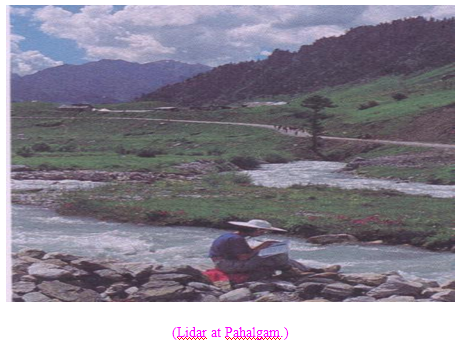
6. The Ferozpore Nullah is an important water-way in the western mountains of Baramulla-Gulmarg area. It collects water from many mountain streams, small lakes and springs. This mountaineous area is mostly full of snow even in summer.
7. The Sind Nullah has its source in the Inner Himalayas at Dras and after it is fed by the Gangabal lake lying at Harmukh mountain (5150 meters), it joins the Jhelum at Shadipur. It is 96 Kms in length. The famous health resorts of Sonamarg and Ganderbal are situated on its banks. Its water is used for irrigation purposes and the ‘Sind Valley Hydroelectric Power Project’ uses its water at Gandarbal to produce electric power. It is navigable from Gandarbal downwards.
8. The Flood Spill Channel was constructed in 1904 to relieve the strain on the Jhelum in the city of Srinagar. By taking 2/3rd of the total flow in the river it helps the river Jhelum to regulate its water level while passing through the city of Srinagar. The Jhelum rises during floods and the Channel saves the city from being flooded.
Lakes :
1. The Wullar Lake in Kashmir is the largest fresh water lake in India. It is about 16 Kms.long and 9 .6 Kms wide with ill-defined shores. This lake lies between Bandipore and Sopore at a distance of 75 Kms. From Srinagar. The Jhelum enters this lake from the south-east and leaves it from thewest. Storms rise in the lake everyday in the afternoon. The deepest part of the lake is at Watlab towards the hill called Baba Sukhuruddin in the north-west. Many small streams, Harbuji, Aarah, Erin and Pohru join this lake.
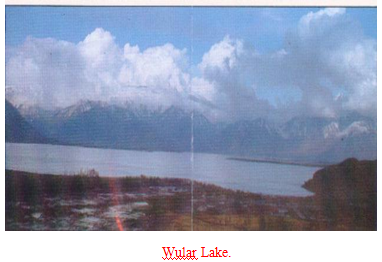
2. The Dal Lake is a beautiful lake near Srinagar. It is 8 Kms long and 6.4 Kms. Wide. It is the flood-lung of the Jhelum. The famous Mughal gardens are situated around it. The lake is an ideal place for swimming and sailing in Shikaras and motorboats. Floating gardens are found in this lake where a large variety of vegetables is grown. The The Dal lake has two parts, the small Dal and the big Dal, separated by a swampy bund. The road round the lake is called Boulevard. There are two artificial islands in the lake, Rupalank and Sonalank, built by Mughal Emperors. Nehru Park is the western terminus of the lake. The lake is a spot of great attraction for visitors, who enjoy staying in house-boats in the lake.
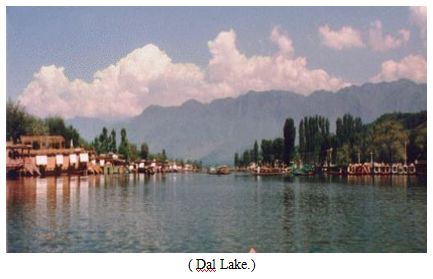
3. The Anchar Lake is a swampy area. The Sind Nullah enters this lake from one side and flows out from the other. It is about 8 Kms long and 3 Kms. Wide. Gandarbal is a famous township on its north-west bank.
4. The Mansbal Lake is at a distance of 29 Kms. From Srinagar and is situated at Safapore (Tehsil Gandarbal). It is 5 Kms long and one Km. Wide. It is connected with the Jhelum by a canal near Sumbal. Mughal Emperors have built a summer palace on its bank.
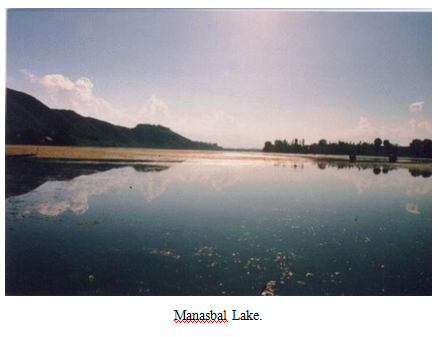
5. The Harvan Lake is situated at a distance of 21 Kms from Srinagar. It is 278 meters long, 137 meters wide and 18 metres deep. This lake is a source of water supply to Srinagar city.
6. The Hokarsar Lake lies on Baramulla road about 13 Kms. From Srinagar. It is about 5 Kms. Long and 1.5 Kms. Wide. Willow trees are grown in abundance around its banks.
7. The Konsarnag or Vishno Pad Lake is situated in the Pir Panjal range at a height of 4000 meters above sea level to the south of Shopian. It is about 5 Kms. Long and 3 Kms. Wide and is the source of the river Vishav. It is at a distance of 34 Kms. From Shopian.
8. The Gangabal Lake is situated at a height of 3570.4M. On the peak of Harmukh mountain. Hindus consider it a sacred lake.
9. The Sheshnag Lake is situated near Vavjan, enroute to Shri Amarnath cave. It is at a distance of 28 Kms. From Pahalgam.
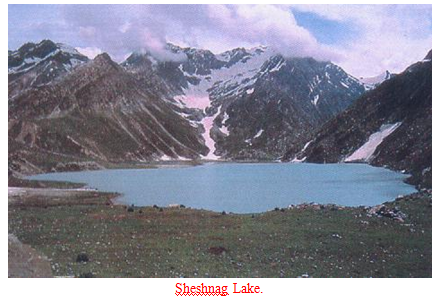
10. The Neelang Lake is situated in Tehsil Badgam at a distance of 10 Kms from Nagam. It is a beautiful lake with dense forests around it.
11. There are two more lakes, Tarsar and Marsar that lie on the northern slope of the Harmukh mountain. Marsar lake is the origin of the Canal Sharab Kohl that provides water to the fountains that play in the Mughal Gardens. Marsar lake flows into the Lidar which is one of the largest tributaries of the Jhelum.
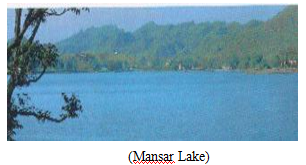
12. Sokh and Dokh are two frozen lakes situated at Harmukh Mountain. These are said to be two tear drops of Parvati; one a warm tear drop indicating happiness and other a cold one showing grief.
Springs :
Kashmir valley abounds in numerous springs of which Verinag (source of the Jhelum), Martand (Anantnag), Achhabal (Anantnag), Kukarnag (Anantnag), Chashma Shahi (famous for its fresh and digestive water, situated near Srinagar on one side of the Boulevard road), Tullamulla or Khirbhawani (a sacred spring), Vicharnag, Sukhnag, Vishnosar and Harmukat Ganga in Srinagar area and Chirnagand Vasaknag in Anantnag are very famous.
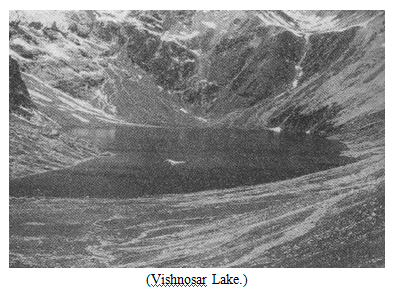
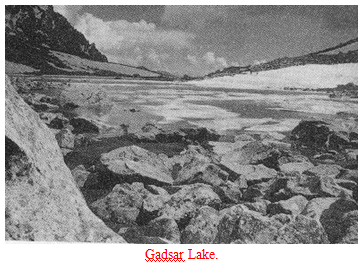
Climate of Kashmir:
The climate found in the zone of the Middle Mountains and the valleys enclosed is of a particular type. Altitude determines the degree of coolness and elevation the form of precipitation and summer temperature. Winter is cold and of long duration. When the monsoons are strong, rain is caused. In higher mountains round the valley of Kashmir, winter is very cold and there is snow-fall. Summer is very short and milder.
The climate in the Valley of Kashmir has its own peculiarities. Winter is very cold. It lasts from November to March. During these months strong winds bring snow and rain from the Mediterranean depressions. These come over from Iran and Afghanistan. Spring begins after 15th of March when rain falls heavily. It causes landslides. But for sowing crops this rain is extremely useful. Rainfall in July and August is as high as 70% and with summer temperature, it causes discomfort. The lakes and waterways make the atmosphere damp and oppressive. The entire valley is covered with a haze that hides the surrounding mountains from view.
The seasons are marked with sudden change and the year is divided into six seasons of two months each.
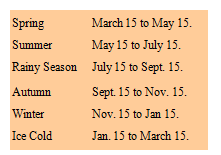
From December 24 to March 8 temperature is often below zero. Strong winds blow from south and southeast. It snows during winter and there are thick black clouds in the sky.
Annual rainfall of the valley recorded is about 75 cms. It rains in July and August and also in March and April . August is the warmest month. Temperature rises to 85 deg. F. January is the coldest month. Temperature falls down to below zero. Longest sunshine hours are in September, October and November.
December has 80% humdity which is the highest and May has 71% which is the lowest. In July atmosphere has a pressure of 62.68 cms.
Disputed area:
The disputed areas of the region of Kashmir. India claims the entire erstwhile princely state of Jammu and Kashmirbased on an instrument of accession signed in 1947. Pakistanclaims all areas of the erstwhile state except for those claimed by China. China claims the Shaksam Valley and Aksai Chin.

Early history:
According to folk etymology, the name “Kashmir” means “desiccated land” (from the Sanskrit: Ka = water and shimeera = desiccate). In the Rajatarangini, ahistory of Kashmir written by Kalhana in the mid-12th century, it is stated that the valley of Kashmir was formerly a lake. According to Hindu mythology, the lake was drained by the great rishi or sage, Kashyapa,son of Marichi,son of Brahma,by cutting the gap in the hills at Baramulla (Varaha-mula). When Kashmir had been drained, Kashyapa asked Brahmans to settle there. This is still the local tradition, and in the existing physical condition of the country, we may see some ground for the story which has taken this form. The name of Kashyapa is by history and tradition connected with the draining of the lake, and the chief town or collection of dwellings in the valley was called Kashyapa-pura, which has been identified with Kaspapyros of Hecataeus (apud Stephanus of Byzantium) and Kaspatyros ofherodotus (3.102, 4.44) Kashmir is also believed to be the country meant by Ptolemy’s Kaspeiria.
In the 18th century, Kashmir was ruled by the Muslim Pashtun Durrani Empire. In 1819, Kashmir was conquered by the Sikh ruler Ranjit Singh. Following the First Anglo-Sikh War in 1845 and 1846, Kashmir was first ceded by the Treaty of Lahore to the East India Company, and shortly after sold by the Treaty of Amritsar togulab Singh, Raja of Jammu, who thereafter was given the title Maharaja of Jammu and Kashmir. From then until the Partition of India in 1947, Kashmir was ruled by the Hindu Maharajas of the princely state of Kashmir and Jammu, although the majority of the population were Muslim, except in the Jammu region.
Partition and dispute:
In 1947, British rule in India ended with the creation of two new nations: the Union of India and the Dominion of Pakistan, while British suzerainty over the 562 Indianprincely states ended. According to the Indian Independence Act 1947, “the suzerainty of His Majesty over the Indian States lapses, and with it, all treaties and agreements in force at the date of the passing of this Act between His Majesty and the rulers of Indian States”, so the states were left to choose whether to join India or Pakistan or to remain independent. Jammu and Kashmir, the largest of the princely states, had a predominantly Muslim population, while having a Hindu ruler (Maharaja Hari Singh.) On partition Pakistan expected Kashmir to be annexed to it.
In October 1947, Muslim revolutionaries in western Kashmir and Pakistani tribals from Dir entered Kashmir, intending to liberate it from Dogra rule. Unable to withstand the invasion, the Maharaja signed the Instrument of Accession on 25 October 1947 that was accepted by the government of India on 27 October 1947.
Indo-Pakistani War of 1947:
After rumours that the Maharaja supported the annexation of Kashmir by India, militant Muslim revolutionaries from western Kashmir and Pakistani tribesmen made rapid advances into the Baramulla sector. Maharaja Hari Singh of Kashmir asked the government of India to intervene. However, India and Pakistan had signed an agreement of non-intervention. Although tribal fighters from Pakistan had entered Jammu and Kashmir, there was no iron-clad legal evidence to unequivocally prove that Pakistan was officially involved. It would have been illegal for India to unilaterally intervene in an open, official capacity unless Jammu and Kashmir officially joined the Union of India, at which point it would be possible to send in its forces and occupy the remaining parts.
The Maharaja desperately needed military assistance when the Pakistani tribals reached the outskirts of Srinagar. Before their arrival into Srinagar, India argued that the Maharaja must complete negotiations for ceding Jammu and Kashmir to India in exchange for receiving military aid. The agreement which ceded Jammu and Kashmir to India was signed by the Maharaja and Lord Mountbatten of Burma. In Jammu and Kashmir, National Conference volunteers worked with the Indian Army to drive out the Pakistanis.
The Instrument of Accession of Kashmir to India was accepted by Viceroy Louis Mountbatten, 1st Earl Mountbatten of Burma.
The resulting war over Kashmir, the First Kashmir War, lasted until 1948, when India moved the issue to the UN Security Council. Sheikh Abdullah was not in favor of India seeking UN intervention because he was sure the Indian Army could free the entire State of invaders. The UN had previously passed resolutions for setting up monitoring of the conflict in Kashmir. Following the set-up of the United Nations Military Observer Group in India and Pakistan (UNCIP), the UN Security Council passed Resolution 47 on 21 April 1948. The resolution imposed an immediate cease-fire and called on Pakistan to withdraw all military presence. The resolution stated that Pakistan would have no say in Jammu and Kashmir politics. India would retain a minimum military presence and “the final disposition of the State of Jammu and Kashmir will be made in accordance with the will of the people expressed through the democratic method of a free and impartial plebiscite conducted under the auspices of the United Nations.” The ceasefire was enacted on 31 December 1948.
The Indian and Pakistani governments agreed to hold the plebiscite, but Pakistan did not withdraw its troops from Kashmir, thus violating the conditions for holding the plebiscite. Over the next several years, the UN Security Council passed four new resolutions, revising the terms of Resolution 47 to include a synchronous withdrawal of both Indian and Pakistani troops from the region, per the recommendations of General Andrew mcnaughton. To this end, UN arbitrators put forward 11 different proposals for the demilitarization of the region. All of these were accepted by Pakistan, but rejected by the Indian government. The resolutions were passed by United Nations Security Council under Chapter VI of the United Nations Charter. Resolutions passed under Chapter VI of the UN charter are considered non-binding and have no mandatory enforceability, as opposed to the resolutions passed under Chapter VII.
Sino-Indian War:
In 1962, troops from the People’s Republic of China and India clashed in territory claimed by both. China won a swift victory in the war, resulting in the Chinese annexation of the region called Aksai Chin, which has continued as of November 2010. Another smaller area, the Trans-Karakoram, was demarcated as the Line of Control (LOC) between China and Pakistan, although some of the territory on the Chinese side is claimed by India to be part of Kashmir. The line that separates India from China in this region is known as the “Line of Actual Control”.
1965 and 1971 wars:
Main articles: Indo-Pakistani War of 1965 and Indo-Pakistani War of 1971
In 1965 and 1971, heavy fighting broke out again between India and Pakistan. The Indo-Pakistani War of 1971 resulted in the defeat of Pakistan and the Pakistani military’s surrender in East Pakistan, leading to the creation of Bangladesh. The Simla Agreement was signed in 1972 between India and Pakistan. By this treaty, both countries agreed to settle all issues by peaceful means using mutual discussion in the framework of the UN Charter.
1989 popular insurgency and militancy:
In the years since 1990, the Kashmiri Muslims and the Indian government have conspired to abolish the complexities of Kashmiri civilization. The world it inhabited has vanished: the state government and the political class, the rule of law, almost all the Hindu inhabitants of the valley, alcohol, cinemas, cricket matches, picnics by moonlight in the saffron fields, schools, universities, an independent press, tourists and banks. In this reduction of civilian reality, the sights of Kashmir are redefined: not the lakes and Mogul gardens, or the storied triumphs of Kashmiri agriculture, handicrafts and cookery, but two entities that confront each other without intermediary: the mosque and the army camp.
In 1989, a widespread popular and armed insurgency started in Kashmir. After the 1987 State legislative assembly election, some of the results were disputed. This resulted in the formation of militant wings after the election and was the beginning of the Mujahadeen insurgency, which continues to this day. India contends that the insurgency was largely started by Afghan mujahadeen who entered the Kashmir valley following the end of the Soviet-Afghan War. Pakistani and Kashmiri nationalists argue that Afghan mujahideen did not leave Afghanistan in large numbers until 1992, three years after the insurgency began. Yasin Malik, a leader of one faction of the Jammu Kashmir Liberation Front, was one of the Kashmiris to organize militancy in Kashmir, along with Ashfaq Majid Wani and Farooq Ahmad Dar (alias Bitta Karatay). Since 1995, Malik has renounced the use of violence and calls for strictly peaceful methods to resolve the dispute. He developed differences with one of the senior leaders, Farooq Siddiqui (alias Farooq Papa), for shunning the demand for an independent Kashmir and trying to cut a deal with the Indian Prime Minister. This resulted in a spilt in which Bitta Karatay, Salim Nanhaji, and other senior comrades joined Farooq Papa. Pakistan claims these insurgents are Jammu and Kashmir citizens, and are rising up against the Indian army in an independence movement. Pakistan accuses the Indian army of committing serious human rights violations in Kashmir. Pakistan denies that it has or currently is supplying weapons and ammunition to the insurgents.
India claims these insurgents are Islamic terrorist groups from Pakistan-administered Kashmir and Afghanistan, fighting to make Jammu and Kashmir, a part of Pakistan. They claim Pakistan is supplying munitions to the terrorists and training them in Pakistan. India states that the terrorists have been killing many citizens in Kashmir and committing human rights violations. They deny that their own armed forces are responsible for human rights abuses. On a visit to Pakistan in 2006 current Chief Minister of Kashmir Omar Abdullah remarked that foreign militants were engaged in reckless killings and mayhem in the name of religion. Indian government has said militancy is now on the decline.
The Pakistani government calls these insurgents “Kashmiri freedom fighters”, and claims that it gives only moral and diplomatic support to these insurgents, though India believes they are Pakistan-supported terrorists from Pakistan Administered Kashmir. In October 2008, President Asif Ali Zardari of Pakistan called the Kashmir separatists, terrorists in an interview with The Wall Street Journal. These comments by Zardari sparked outrage amongst many Kashmiris, some of whom defied a curfew by the Indian army to burn him in effigy.
There has been a “purely indigenous, purely Kashmiri” peaceful protest movement alongside the insurgency in Indian-administered Kashmir since 1989. The movement was created for the same reason as the insurgency; it began with the disputed election of 1987. The Kashmiris have grievances with the Indian government, specifically the Indian Military, which has committed human rights violations, according to the United Nations
Al-Qaeda involvement:
In a ‘Letter to American People’ written by Osama bin Laden in 2002, he stated that one of the reasons he was fighting America is because of its support of India on the Kashmir issue. While on a trip to Delhi in 2002, U.S. Secretary of Defense Donald Rumsfeld suggested that Al-Qaeda was active in Kashmir, though he did not have any hard evidence. An investigation in 2002 unearthed evidence that Al-Qaeda and its affiliates were prospering in Pakistan-administered Kashmir with tacit approval of Pakistan’s National Intelligence agency Inter-Services Intelligence. A team of Special Air Service and Delta Force was sent intoindian-administered Kashmir in 2002 to hunt for Osama bin Laden after reports that he was being sheltered by the Kashmiri militant group Harkat-ul-Mujahideen. U.S. officials believed that Al-Qaeda was helping organize a campaign of terror in Kashmir in order to provoke conflict between India and Pakistan. Their strategy was to force Pakistan to move its troops to the border with India, thereby relieving pressure on Al-Qaeda elements hiding in northwestern Pakistan. U.S. intelligence analysts say Al-Qaeda and Taliban operatives in Pakistan-administered Kashmir are helping terrorists they had trained in Afghanistan to infiltrate Indian-administered Kashmir. Fazlur Rehman Khalil, the leader of the Harkat-ul-Mujahideen, signed al-Qaeda’s 1998 declaration of holy war, which called on Muslims to attack all Americans and their allies. In 2006 Al-Qaeda claim they have established a wing in Kashmir; this worried the Indian government. Indian Army Lt. Gen. H.S. Panag, GOC-in-C Northern Command, said to reporters that the army has ruled out the presence of Al-Qaeda in Indian-administered Jammu and Kashmir. He said that there no evidence that verifies reports from the media of an Al-Qaeda presence in the state. He stated that Al-Qaeda had strong ties with the Kashmir militant groups Lashkar-e-Taiba and Jaish-e-Mohammed in Pakistan. While on a visit to Pakistan in January 2010, U.S. Defense
secretary Robert Gates stated that Al-Qaeda was seeking to destabilize the region and planning to provoke a nuclear war between India and Pakistan.
In September 2009, a U.S. Drone strike reportedly killed Ilyas Kashmiri, who was the chief of Harkat-ul-Jihad al-Islami, a Kashmiri militant group associated with Al-Qaeda. Kashmiri was described by Bruce Riedel as a ‘prominent’ Al-Qaeda member, while others described him as the head of military operations for Al-Qaeda. Waziristan had now become the new battlefield for Kashmiri militants, who were now fighting NATO in support of Al-Qaeda. Ilyas Kashmiri was charged by the U.S. in a plot against Jyllands-Posten, the Danish newspaper which was at the center of Jyllands-Posten Muhammad cartoons controversy.
Indian Army Lt. Gen. H.S. Panag, GOC-in-C Northern Command told reporters that the army has ruled out the presence of Al-Qaeda in Jammu and Kashmir, and that there is no evidentce that confirms an Al Qaeda presence in the state.
Conflict in Kargil:

In mid-1999, insurgents and Pakistani soldiers from Pakistani Kashmir infiltrated into
Jammu and Kashmir. During the winter season, Indian forces regularly move down to lower altitudes, as severe climatic conditions makes it almost impossible for them to guard the high peaks near the Line of Control. The insurgents took advantage of this and occupied vacant mountain peaks of the Kargil range overlooking the highway in Indian Kashmir that connects Srinagar and Leh. By blocking the highway, they wanted to cut off the only link between the Kashmir Valley and Ladakh. This resulted in a high-scale conflict between the Indian Army and the Pakistan Army.
Fears of the Kargil War turning into a nuclear war provoked the then-United States President Bill Clinton to pressure Pakistan to retreat. Faced with mounting losses of personnel and posts, the Pakistan Army withdrew their remaining troops from the area,
ending the conflict. India reclaimed control of the peaks, which they now patrol and monitor all year long.
Reasons behind dispute:
The Kashmir Conflict arises from the Partition of India in 1947 into modern India and Pakistan. Both the countries have made claims to Kashmir, based on historical developments and religious affiliations of the Kashmiri people. The state of Jammu and Kashmir, which lies strategically in the north-west of the subcontinent, bordering China and the former Soviet Union, was a princely state ruled by Maharaja Hari Singh under the paramountcy of British India. In geographical and legal terms, the Maharaja could have joined either of the two new Dominions. Although urged by the Viceroy, Lord Mountbatten of Burma, to determine the future of his state before the transfer of power took place, Singh demurred. In October 1947, incursions by Pakistan took place leading to a war, as a result of which the state ofjammu and Kashmir remains divided between the two countries.
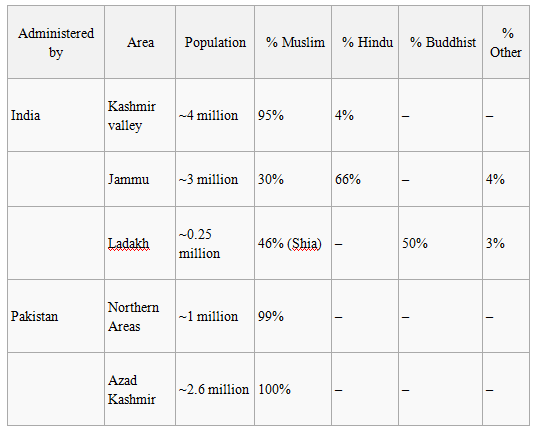
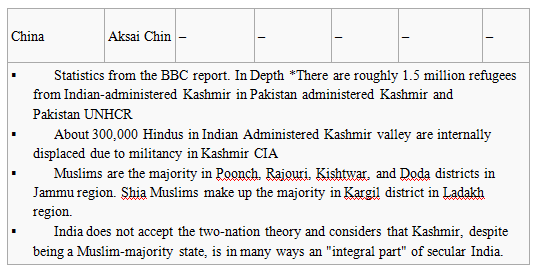
Two-thirds of the former princely state (known as the Indian state of Jammu and Kashmir), comprising Jammu, the Kashmir Valley, and the sparsely populatedbuddhist area of Ladakh are controlled by India; one-third is administered by Pakistan. The latter includes a narrow strip of land called Azad Kashmir and the Northern Areas, compromising the Gilgit Agency, Baltistan, and the former kingdoms of Hunza and Nagar. Attempts to resolve the dispute through political discussions were unsuccessful. In September 1965, war broke out again between Pakistan and India. The United Nations called for another cease-fire, and peace was restored once again following the Tashkent Declaration in 1966, by which both nations returned to their original positions along the demarcated line. After the1971 war and the creation of independent Bangladesh, under the terms of the 1972 Simla Agreement between Prime Minister Indira Gandhi of India and Zulfiqar Ali Bhutto of Pakistan, it was agreed that neither country would seek to alter the cease-fire line in Kashmir, which was renamed as the Line of Control, “unilaterally, irrespective of mutual differences and legal interpretations”.
Numerous violations of the Line of Control have occurred, including the incursions by insurgents and Pakistani armed forces at Kargil leading to the Kargil war. There are also sporadic clashes on the Siachen Glacier, where the Line of Control is not demarcated and both countries maintain forces at altitudes rising to 20,000 ft (6,100 m), with the Indian forces serving at higher altitudes.
Indian view:
Maharaja Hari Singh signed theinstrument of Accession in October 1947 under which he acceded the State of Jammu and Kashmir to the Union of India.The Indian viewpoint is succinctly summarized by Ministry of External affairs, Government of India.
India holds that the Instrument of Accession of the State of Jammu and Kashmir to the Union of India, signed by Maharaja Hari Singh (erstwhile ruler of the State) on 25 October 1947 & executed on 27 October 1947between the ruler of Kashmir and the Governor General of India was a legal act, was completely valid in terms of the Government of India Act (1935), Indian Independence Act (1947) and international law and was total and irrevocable. There is no evidence of any deceit practiced by India on Kashmir. The Government of India had no right to question the right of the Maharaja to sign the Instrument of Accession, as he alone had the right and power to take a decision for his state. To have asked the ruler to establish his right to sign the Instrument of Accession would have meant that the Government of India was going to meddle with the internal policies of the state. Law does not permit any such intervention in the affairs of another state.
The Constituent assembly of Jammu and Kashmir had unanimously ratified the Maharaja’s Instrument of Accession to India and had adopted a constitution for the state that called for a perpetual merger of Jammu and Kashmir with the Union of India. India claims that the Constituent assembly was a representative one, and that its views were those of the Kashmiri people at the time.
United Nations Security Council Resolution 1172 tacitly accepts India’s stand regarding all outstanding issues between India and Pakistan and urges the need to resolve the dispute through mutual dialogue and does not call for a plebiscite.
United Nations Security Council Resolution 47 cannot be implemented since Pakistan failed to withdraw its forces from Kashmir, which was the first step in implementing the resolution. India is also of the view that Resolution 47 is obsolete, since the geography and demographics of the region have been permanently altered. The resolution was passed by United Nations Security Council under Chapter VI of the United Nations Charter. It is therefore non-binding and has no mandatory enforceability, as opposed to the resolutions passed under Chapter VII.
India does not accept the two-nation theory that forms the basis of Pakistan and considers that Kashmir, despite being a Muslim-majority state, is in many ways an “integral part” of secular India.
The state of Jammu and Kashmir was provided significant autonomy in Article 370 of the Constitution of India.
All differences between India and Pakistan, including Kashmir, need to be settled through bilateral negotiations as agreed to by the two countries when they signed the Simla Agreement on 2 July 1972.
Indian security personnel guard jusbrlrailway station in Anantnag, Kashmir. India has accused Pakistan of sponsoring terrorism in the region.
Additional Indian viewpoints regarding the broader debate over the Kashmir conflict include —
- In a diverse country like India, disaffection and discontent are not uncommon. Indian democracy has the necessary resilience to accommodate genuine grievances within the framework of India’s sovereignty, unity, and integrity. The Government of India has expressed its willingness to accommodate the legitimate political demands of the people of the state of Kashmir.
- Insurgency and terrorism in Kashmir is deliberately being fueled by Pakistan to create instability in the region. The Government of India has repeatedly accused Pakistan of waging a proxy war in Kashmir by providing weapons and financial assistance to terrorist groups in the region.
- Pakistan is trying to raise anti-India sentiment among the people of Kashmir by spreading false propaganda against India. According to the state government of Jammu and Kashmir, Pakistani radio and television channels deliberately spread “hate and venom” against India to alter Kashmiri opinion.
- India has asked the United Nations not to leave unchallenged or unaddressed the claims of moral, political, and diplomatic support for terrorism, which were clearly in contravention of United Nations Security Council Resolution 1373. This is a Chapter VII resolution that makes it mandatory for member states to not provide active or passive support to terrorist organizations. Specifically, it has pointed out that the Pakistani government continues to support various terrorist organizations, such as Jaish-e-Mohammad and Lashkar-e-Taiba, in direct violation of this resolution.
- India points out reports by human rights organizations condemning Pakistan for the lack of civic liberties in Pakistan-administered Kashmir. According to India, most regions of Pakistani Kashmir, especially Northern Areas, continue to suffer from lack of political recognition, economic development, and basic fundamental rights.
- Dr Karan Singh, the state’s first and last sadar-e-riyast and son of the last Dogra ruler of Jammu and Kashmir Maharaja Hari Singh said that the Instrument of Accession signed by Maharaja Hari Singh was the same as signed by other states; however the state had its own separate constitution. That is why the state has special status and Article 370. With the signing of Instrument of Accession, it became an integral part of India.
Pakistani view:
Map of Kashmir as drawn by the Government of Pakistan
Pakistan’s claims to the disputed region are based on the rejection of Indian claims to Kashmir, namely the Instrument of Accession. Pakistan insists that the Maharaja was not a popular leader, and was regarded as a tyrant by most Kashmiris Pakistan maintains that the Maharaja used brute force to suppress the population. Pakistan accuses India of hypocrisy, as it refused to recognize the accession of Junagadh to Pakistan
and Hyderabad’s independence, on the grounds that those two states had Hindu majorities (in fact, India had occupied and forcibly integrated those two territories). Since he had fled Kashmir due to Pakistani invasion, Pakistan asserts that the Maharaja held no authority in determining Kashmir’s future. Pakistan argues that even if the Maharaja had any authority in determining the plight of Kashmir, he signed the Instrument of Accession under duress, thus invalidating the legitimacy of his actions.
Pakistan claims that Indian forces were in Kashmir before the Instrument of Accession was signed with India, and that therefore Indian troops were in Kashmir in violation of the Standstill Agreement, which was designed to maintain the status quo in Kashmir (although India was not signatory to the Agreement, which was signed between Pakistan and the Hindu ruler of Jammu and Kashmir).
From 1990 to 1999, some organizations reported that the Indian Armed Forces, its paramilitary groups, and counter-insurgent militias were responsible for the deaths of 4,501 Kashmiri civilians. Also from 1990 to 1999, there were records of 4,242 women between the ages of 7–70 being raped. Similar allegations were also made by some human rights organizations.
In short, Pakistan holds that:
- The popular Kashmiri insurgency demonstrates that the Kashmiri people no longer wish to remain within India. Pakistan suggests that this means that Kashmir either wants to be with Pakistan or independent.
- According to the two-nation theory, which is one of the theories that is cited for the partition that created India and Pakistan, Kashmir should have been with Pakistan, because it has a Muslim majority.
- India has shown disregard to the resolutions of the UN Security Council and the United Nations Commission in India and Pakistan by failing to hold a plebiscite to determine the future allegiance of the state.
- The Kashmiri people have now been forced by circumstances to uphold their right of self-determination through militancy. Pakistan claims to give the Kashmiri insurgents moral, ethical and military support (see 1999 Kargil Conflict).
- Recent protests in Indian-administered Kashmir attracted a large number of people to massive rallies that took place to oppose Indian control of the state.
- Pakistan points to the violence that accompanies elections in Indian Kashmir and the anti Indian sentiments expressed by some people in the state.
- Pakistan has noted the widespread use of extrajudicial killings in Indian-administered Kashmir carried out by Indian security forces while claiming they were caught up in encounters with militants. These encounters are commonplace in Indian-administered Kashmir. The encounters go largely uninvestigated by the authorities, and the perpetrators are spared criminal prosecution.
- Pakistan points towards reports from the United Nations which condemn India for its human rights violations against Kashmiri people. Human rights organizations have strongly condemned Indian troops for widespread rape and murder of innocent civilians while accusing these civilians of being militants.
- Pakistan President Asif Ali Zardari stated in October 2008 that Kashmiri ‘freedom fighters’ were terrorists. His remarks were met with widespread condemnation across Pakistan and Kashmir, including from prominent politicians.
- The Chenab formula was a compromise proposed in the 1960s, in which the Kashmir valley and other Muslim-dominated areas north of the Chenab river would go to Pakistan, and Jammu and other Hindu-dominated regions would go to India
Chinese view:
- Chinese never accepted the British negotiated boundary in the north east area of the princely state of Kashmir (Aksai Chin).
- The Chinese settled their border disputes in the region with Pakistan in 1963.
Cross-border troubles:
The border and the Line of Control separating Indian and Pakistani Kashmir passes through some exceptionally difficult terrain. The world’s highest battleground, the Siachen Glacier, is a part of this difficult-to-man boundary. Even with 200,000 military personnel, India maintains that it is infeasible to place enough men to guard all sections of the border throughout the various seasons of the year. Pakistan has indirectly acquiesced its role in failing to prevent “cross border terrorism” when it agreed to curb such activities after intense pressure from the Bush administration in mid 2002.
The Government of Pakistan has repeatedly claimed that by constructing a fence along the line of control, India is violating the Shimla Accord. India claims the construction of the fence has helped decrease armed infiltration into Indian-administered Kashmir.
In 2002, Pakistani President and Army Chief General Pervez Musharraf promised to check infiltration into Jammu and Kashmir.
Water dispute:
Another reason for the dispute over Kashmir is water. Kashmir is the origin point for many rivers and tributaries of the Indus River basin. They include the Jhelumand Chenab rivers, which primarily flow into Pakistan while other branches—the Ravi, Beas, and the Sutlej—irrigate northern India. The Boundary Award of 1947 meant that the headwaters of Pakistani irrigation systems were in Indian territory. Pakistan has been apprehensive that in a dire need, India (under whose portion of Kashmir lies the origins and passage of these rivers) would withhold the flow and thus choke the agrarian economy of Pakistan. The Indus Waters Treaty signed in 1960 resolved most of these disputes over water, calling for mutual cooperation in this regard. But the treaty faced issues raised by Pakistan over the construction of dams on the Indian side which limit water flow to the Pakistani side.
Human Rights abuse:
A Kashmiri Pandit child killed by Kashmiri separatists. Circa early 1990’s.
In Jammu and Kashmir, the Islamic insurgency has claimed to have specifically targeted the Hindu Kashmiri Pandit minority and violated their human rights. 400,000 Kashmiri Hindus have either been murdered or displaced. The violence was condemned and labeled as ethnic cleansing in a 2006 resolution passed by the United States Congress. The CIA has reported about 300,000 Pandit Hindus and over 100,000 Kashmiri Muslims from Indian Administered Kashmir are internally displaced due to the insurgency. The United Nations Commission on Human Rights reports that there are roughly 1.5 million refugees from Indian-administered Kashmir in Pakistan-administered Kashmir and in Pakistan.
Claims of human rights abuses have been made against the Indian Armed Forces and the armed militants operating in Jammu and Kashmir. A 2005 study conducted by Médecins Sans Frontières found that Kashmiri women are among the worst sufferers of sexual violence in the world, with 11.6% of respondents reporting that they had been victims of sexual abuse. Some surveys have found that in the Kashmir region itself (where the bulk of separatist and Indian military activity is concentrated), popular perception holds that the Indian Armed Forces are more to blame for human rights violations than the separatist groups. According to the MORI survey of 2002, in Kashmir only 2% of respondents believed that the militant groups were guilty of widespread human rights abuses, while 64% believed that Indian troops were guilty of the same. This trend was reversed in other parts of the state. Amnesty International has called on India to “unequivocally condemn enforced disappearances” and to ensure that impartial investigation is conducted on mass graves in its Kashmir region. The Indian state police confirms as many as 331 deaths while in custody and 111 enforced disappearances since 1989. Amnesty International criticised the Indian Military regarding an incident on 22 April 1996, when several armed forces personnel forcibly entered the house of a 32-year-old woman in the village of Wawoosa in the Rangreth district of Jammu and Kashmir. They reportedly molested her 12-year-old daughter and raped her other three daughters, aged 14, 16, and 18. When another woman attempted to prevent the soldiers from attacking her two daughters, she was beaten. Soldiers reportedly told her 17-year-old daughter to remove her clothes so that they could check whether she was hiding a gun. They molested her before leaving the house. However in October 2010, Army Chief Gen VK Singh stated in an interview that over 95% of the allegations of human rights violations proved to be false and had apparently been levelled with the “ulterior motive of maligning the armed forces”. Giving details, he said 988 allegations against the Army personnel in Jammu and Kashmir were received since 1994. Out of these 965 cases were investigated and 940 were found false, accounting for 95.2 percent.
Several international agencies and the UN have reported human rights violations in Indian-administered Kashmir. In a recent press release the OHCHR spokesmen stated “The Office of the High Commissioner for Human Rights is concerned about the recent violent protests in Indian-administered Kashmir that have reportedly led to civilian casualties as well as restrictions to the right to freedom of assembly and expression.” A 1996 Human Rights Watch report accuses the Indian military and Indian-government backed paramilitaries of “committ[ing] serious and widespread human rights violations in Kashmir.” One such alleged massacre occurred on 6 January 1993 in the town of Sopore. TIME Magazine described the incident as such: “In retaliation for the killing of one soldier, paramilitary forces rampaged through Sopore’s market, setting buildings ablaze and shooting bystanders. The Indian government pronounced the event ‘unfortunate’ and claimed that an ammunition dump had been hit by gunfire, setting off fires that killed most of the victims.” There have been claims of disappearances by the police or the army in Kashmir by several human rights organizations. Jammu and Kashmir Public Safety Act, 1978: Human rights organizations have asked Indian government to repeal the Public Safety Act, since “a detainee may be held in administrative detention for a maximum of two years without a court order.”
A soldier guards the roadside checkpoint outside Srinagar International Airport in January 2009.
Many human rights organizations such as Amnesty International and the Human Rights Watch (HRW) have condemned human rights abuses in Kashmir by Indians such as “extra-judicial executions”, “disappearances”, and torture. The “Armed Forces Special Powers Act” grants the military, wide powers of arrest, the right to shoot to kill, and to occupy or destroy property in counterinsurgency operations. Indian officials claim that troops need such powers because the army is only deployed when national security is at serious risk from armed combatants. Such circumstances, they say, call for extraordinary measures. Human rights organizations have also asked Indian government to repea the Public Safety Act, since “a detainee may be held in administrative detention for a maximum of two years without a court order.” A 2008 report by the United Nations High Commissioner for Refugees determined that Indian Administered Kashmir was only ‘partly free’. A recent report by Amnesty International stated that up to 20,000 people have been detained by draconian laws in Indian-administered Kashmir.
Pakistan administered Kashmir:
Pakistan, an Islamic Republic, imposes multiple restrictions on peoples’ religious freedom in areas of Kashmir under its control. Shias and Ismailis are subject to discrimination and have been targets of sectarian violence. The majority of the population of the Northern Areas is Shia, unlike the rest of Pakistan, in which the majority is Sunni. The constitution of Azad Kashmir specifically prohibits activities that may be prejudicial to the state’s accession to Pakistan, and as such regularly suppresses demonstrations against the government. A number of Islamist militant groups operate in this area including Al-Qaeda, with tacit permission from Pakistan’s intelligence. As in Indian administered Kashmir, there have been allegations of human rights abuse. The Balawaristan National Front has a stated goal of seeking independence from Pakistan. Abdul Hamid Khan, chairman of the Balawaristan National Front, states that “the Pakistani administration has also been involved in efforts to alter the demographic profile of Pakistan-occupied Gilgit-Baltistan, reducing the indigenous people to a minority. The Gilgit-Baltistan area is administered directly by Islamabad. The population, primarily Shia Muslims, was brought under one federally-administered territory (administered by Pakistan) on 16 November 1947, in the name of Islam.’ Other groups like Gilgit-Baltistan United Movement are demanding full autonomy for the areas of Gilgit and Baltistan. On 8 January 2005, 11 people were killed following an armed attack on a Shia leader. A two-day conference on Gilgit-Baltistan was held on 8–9 April 2008 at the European Parliament in Brussels under the auspices of the International Kashmir Alliance. Several members of the European Parliament expressed concern over the human rights violation in Gilgit-Baltistan, and urged the government of Pakistan to establish democratic institutions and rule of law in the area. Abdul Hamid Khan, speaking at the same conference, said “no democratically elected representative (from Gilgit-Baltistan) was included whenkarachi Agreement was signed between Pakistan and Muslim Conference leaders in 1949.” According to Shaukat Ali, chairman of the International Kashmir Alliance, “On one hand Pakistan claims to be the champion of the right of self-determination of the Kashmiri people, but she has denied the same rights under its controlled parts of Kashmir and Gilgit-Baltistan”.Gilgit-Baltistan region has been described a “simmering cauldron of discontent”. Continued deprivation of their human rights has driven people to desperation. Many people think that they are under the colonial rule of the Pakistani government and have boycotted independence day celebrations. Since independence, the Pakistan government has made no attempts to provide basic human rights in the region and no democratic setup exists.
A report titled “Kashmir: Present Situation and Future Prospects”, which was submitted to the European Parliament by Emma Nicholson, Baroness Nicholson of Winterbourne, was critical of the lack of human rights, justice, democracy, and Kashmiri representation in the Pakistan National Assembly.
International Crisis Group stated that “Almost six decades after Pakistan’s independence, the constitutional status of the Federally Administered Northern Areas (Gilgit and Baltistan), once part of the former princely state of Jammu and Kashmir and now under Pakistani control, remains undetermined, with political autonomy a distant dream. The region’s inhabitants are embittered by Islamabad’s unwillingness to devolve powers in real terms to its elected representatives, and a nationalist movement, which seeks independence, is gaining ground. The rise of sectarian extremism is an alarming consequence of this denial of basic political rights”.
In 2009, the Pakistan government implemented an autonomy package for the people of Gilgit-Baltistan. The package was rejected as an “eyewash” by the Balawaristan National Front, whose spokesperson stated, “It’s meant to distract the international community from the violation of human rights in this region.” Manzoor Hussain Parwana, chairman of the Gilgit-Baltistan United Movement, stated “The so-called provincial setup aims at concealing the human rights violations and continue the colonial control over the region.” The first step was an election to elect a Gilgit-Baltistan assembly, amidst criticism of this move by Pakistan.Reuters has reported that many of the people from the region would rather join Pakistan as a province than integrate into Kashmir, but many people protested the elections, with some carrying banners reading “Pakistan’s expansionist designs in Gilgit-Baltistan are unacceptable”. In December 2009, activists of nationalist Kashmiri groups staged a protest in Muzaffarabad to condemn the rigging of elections and “state terrorism” by Pakistani forces.
According to the Human Rights Commission of Pakistan, Pakistan’s Inter Services Intelligence operates in Pakistan-administered Kashmir and is involved in extensive surveillance, arbitrary arrests, torture, and murder. Generally this is done with impunity and perpetrators go unpunished. The 2008 report by the United Nations High Commissioner for Refugees determined that Pakistan-administered Kashmir was ‘Not free’.
United Nations’ map of Jammu and Kashmir, accepted by the Kashmir’s and the Pakistani government
As with other disputed territories, each government issues maps depicting their claims in Kashmir territory, regardless of actual control. It is illegal in India to exclude all or part of Kashmir in a map. It is illegal in Pakistan not to include the state of Jammu and Kashmir as disputed territory, as permitted by the United Nations. Non-participants often use the Line of Control and the Line of Actual Control as the depicted boundaries, as is done in the CIA World Factbook, and the region is often marked out in hash marks, although the Indian government strictly opposes such practices. When Microsoft released a map in Windows 95 and mappoint 2002, a controversy was raised because it did not show all of Kashmir as part of India as per the Indian claim. All the neutral and Pakistani
Map issues
companies claim to follow the UN’s map and over 90% of all maps containing the territory of Kashmir show it as disputed territory.
The boundaries, names, and designations used on the map prepared by the United Nations do not imply official endorsement or acceptance by the United Nations, the Commonwealth Secretariat, or the publishers concerning the legal status of any country, territory or area, or of its authorities, or concerning the delimitation of its frontiers or boundaries. There is no intention to define the status of Jammu and/or Kashmir, which has not yet been agreed upon by the parties. A dotted line represents the Line of Control agreed upon by the Republic of India and the Government of Pakistan since 1972. Both parties have not yet agreed upon the final status of the region, and nothing significant has been implemented since the peace process began in 2004.
The Government of Pakistan maintains unprovisionally and unconditionally that the informal accession of Jammu and Kashmir to Pakistan or to the Republic of India remains to be decided by UN plebiscite. It accepts the UN’s map of the territory.
The Government of India states that “the external artificial boundaries of India, especially concerning the Kashmir region under its jurisdiction created by a foreign body are neither correct nor authenticated.
Recent Developments:
India continues to assert their sovereignty or rights over the entire region of Kashmir, while Pakistan maintains that it is a disputed territory. Pakistan argues that the status quo cannot be considered as a solution. Pakistan insists on a UN-sponsored plebiscite. Unofficially, the Pakistani leadership has indicated that they would be willing to accept alternatives such as a demilitarized Kashmir, if sovereignty of Azad Kashmir was to be extended over the Kashmir valley, or the “Chenab” formula, by which India would retain parts of Kashmir on its side of the Chenab river, and Pakistan the other side – effectively re-partitioning Kashmir on communal lines. The problem is that the population of the Pakistan-administered portion of Kashmir is for the most part ethnically, linguistically, and culturally different from the Valley of Kashmir, a part of Indian-administered Kashmir. Therefore a partition on the Chenab formula is opposed by most Kashmiri politicians from all spectrums, though some, such as Sajjad Lone, have suggested that the non-Muslim part of Jammu and Kashmir be separated from Kashmir and handed to India. Some political analysts say that the Pakistan state policy shift and mellowing of its aggressive stance may have to do with its total failure in the Kargil War and the subsequent 9/11 attacks. These events put pressure on Pakistan to alter its position on terrorism. Many neutral parties to the dispute have noted that the UN resolution on Kashmir is no longer relevant. The European Union has viewed that the plebiscite is not in Kashmiris’ interest. The report notes that the UN conditions for such a plebiscite have not been, and can no longer be, met by Pakistan. The Hurriyat Conference observed in 2003 that a “plebiscite [is] no longer an option”. Besides the popular factions that support either parties, there is a third faction which supports independence and withdrawal of both India and Pakistan. These have been the respective stands of the parties for long, and there have been no significant changes over the years. As a result, all efforts to solve the conflict have been futile so far.
The Freedom in the World 2006 report categorized Indian-administered Kashmir as “partly free”, and Pakistan-administered Kashmir, as well as the country of Pakistan, as “not free”. India claims that contrary to popular belief, a large proportion of the Jammu and Kashmir populace wishes to remain with India. A MORI survey found that within the Kashmir Valley, 9% of respondents said they felt they would be better off as Indian citizens, with 78% saying that they did not know, and the remaining 13% favouring Pakistani citizenship. According to a 2007 poll conducted by the Centre for the Study of Developing Societies in New Delhi, 87% of respondents in the Kashmir Valley prefer independence over union with India or Pakistan.
The 2005 Kashmir earthquake, which killed over 80,000 people, led to India and Pakistan finalizing negotiations for the opening of a road for disaster relief through Kashmir.
Efforts to end the crisis
The 9/11 attacks on the United States resulted in the U.S. government wanting to restrain militancy in the world, including Pakistan. They urged Islamabad to cease infiltrations, which continue to this day, by Islamist militants into Indian-administered Kashmir. In December 2001, a terrorist attack on the Indian Parliamentlinked to Pakistan, resulted in war threats, massive deployment, and international fears of a nuclear war in the subcontinent.
After intensive diplomatic efforts by other countries, India and Pakistan began to withdraw troops from the international border on 10 June 2002, and negotiations began again. Effective 26 November 2003, India and Pakistan agreed to maintain a ceasefire along the undisputed international border, the disputed Line of Control, and the Siachen glacier. This is the first such “total ceasefire” declared by both powers in nearly 15 years. In February 2004, Pakistan increased pressure on Pakistanis fighting in Indian-administered Kashmir to adhere to the ceasefire. The neighbours launched several other mutual confidence-building measures. Restarting the bus service between the Indian- and Pakistani- administered Kashmir has helped defuse the tensions between the countries. Both India and Pakistan have decided to cooperate on economic fronts.
On 5 December 2006, Pakistani President Pervez Musharraf told an Indian TV channel that Pakistan would give up its claim on Kashmir if India accepted some of his peace proposals, including a phased withdrawal of troops, self-governance for locals, no changes in the borders of Kashmir, and a joint supervision mechanism involving India, Pakistan, and Kashmir. Musharraf stated that he was ready to give up the United Nations’ resolutions regarding Kashmir.
2008 militant attacks:
In the week of 10 March 2008, 17 people were wounded when a blast hit the region’s only highway overpass located near the Civil Secretariat—the seat of government of Indian-controlled Kashmir—and the region’s high court. A gun battle between security forces and militants fighting against Indian rule left five people dead and two others injured on 23 March 2008. The battle began when security forces raided a house on the outskirts of the capital city of Srinagar, housing militants. The Indian Army has been carrying out cordon-and-search operations against militants in Indian-administered Kashmir since the violence broke out in 1989. While the authorities say 43,000 persons have been killed in the violence, various rights groups and non-governmental organizations have put the figure at twice that number.
According to the Government of India Home Ministry, 2008 was the year with the lowest civilian casualties in 20 years, with 89 deaths, compared to a high of 1,413 in 1996. 85 security personnel died in 2008 compared to 613 in 2001, while 102 militants were killed. The human rights situation improved, with only one custodial death, and no custodial disappearances. Many analysts say Pakistan’s preoccupation with jihadis within its own borders explains the relative calm.
2008 Kashmir protests:
Massive demonstrations occurred after plans by the Indian-administered Jammu and Kashmir state government to transfer 100 acres (0.40 km2) of land to a trust which runs the Hindu Amarnath shrine in the Muslim-majority Kashmir valley. This land was to be used to build a shelter to house Hindu pilgrims temporarily during their annual pilgrimage to the Amarnath temple.
Indian security forces and the Indian army responded quickly to keep order. More than 40 unarmed protesters were killed and at least 300 were detained. The largest protests saw more than a half million people waving Pakistani flags and crying for freedom at a rally on 18 August, according to Time magazine. Pro-independence Kashmir leader Mirwaiz Umar Farooq warned that the peaceful uprising could lead to an upsurge in violence if India’s heavy-handed crackdown on protests was not restrained. The United Nations expressed concern on India’s response to peaceful protests and urged investigations be launched against Indian security personnel who had taken part in the crackdown.
Separatists and workers of a political party were believed to be behind stone-pelting incidents, which led to retaliatory fire by the police. An autorickshaw laden with stones meant for distribution was seized by the police in March 2009. Following the
unrest in 2008, secessionist movements got a boost.
2008 Kashmir elections:
State elections were held in Indian-held Kashmir in seven phases, starting 17 November and finishing on 24 December 2008. In spite of calls by separatists for a boycott, an unusually high turnout of almost 50% was recorded. The National Conference party, which was founded by Sheikh Abdullah and is regarded as pro-India, emerged with a majority of the seats. On 30 December, the National Congress Party and the National Conference agreed to form a coalition government, with Omar Abdullah as Chief Minister. On 5 January 2009, Abdullah was sworn in as the eleventh Chief Minister of Jammu and Kashmir.
In March 2009, Abdullah stated that only 800 militants were active in the state and out of these only 30% were Kashmiris.
2009 Kashmir protests:
In 2009, protests started over the alleged rape and murder of two young women in Shopian in South Kashmir. Suspicion pointed towards the police as the perpetrators. A judicial enquiry by a retired High Court confirmed the suspicion, but a CBI enquiry reversed their conclusion. It gave a fresh impetus to the popular agitation against India. Significantly, the unity between the separatist parties was lacking this time.
2010 Kashmir Unrest:
The 2010 Kashmir unrest were a series of protests in the Muslim majority Kashmir Valley in Jammu & Kashmir which started in June 2010. These protests occurred in response to ‘Quit Jammu Kashmir Movement’ which was a civil disobedience movement launched by Hurriyat Conference led by Syed Ali Shah Geelaniand Mirwaiz Umar Farooq, who had called for the complete demilitarization of Jammu and Kashmir. The All Parties Hurriyat Conference made this call to protest, citing human rights abuses by Indian troops. Protesters shouting pro-independence slogans, defied curfew, attacked security forces with stones and burnt police vehicles and government buildings. The Jammu and Kashmir Police and Indian Para-military forces fired live ammunition on the protesters, resulting in 112 deaths, including many teenagers. The protests subsided after the Indian government announced a package of measures aimed at defusing the tensions in September 2010.
Obama on the conflict:
In an interview with Joe Klein of Time magazine in October 2008, Barack Obama expressed his intention to try to work with India and Pakistan to resolve the crisis. He said he had talked to Bill Clinton about it, as Clinton has experience being a mediator. In an editorial in The Washington Times, Selig S Harrison, director of the Asia Programme at the Center for International Policy and a senior scholar of the Woodrow Wilson International, called it Obama’s first foreign policy mistake. In an editorial, The Australian called Obama’s idea to appoint a presidential negotiator “a very stupid and dangerous move indeed”. In an editorial in Forbes, Reihan Salam, associate editor for The Atlantic, noted “The smartest thing President Obama could do on Kashmir is probably nothing. We have to hope that India and Pakistan can work out their differences on Kashmir on their own”. The Boston Globe called the idea of appointing Bill Clinton as an envoy to Kashmir “a mistake”. President Obama appointed Richard Holbrooke as special envoy to Pakistan and Afghanistan. President Asif Ali Zardari hoped that Holbrooke would help mediate to resolve the Kashmir issue. Subsequently Kashmir was removed from the mandate of Holbrooke. “Eliminating … Kashmir from his job description … Is seen as a significant diplomatic concession to India that reflects increasingly warm ties between the country and the United States,”The Washington Post noted in a report. Brajesh Mishra, India’s former national security adviser, was quoted in the same report as saying that “No matter what government is in place, India is not going to relinquish control of Jammu and Kashmir”. “That is written in stone and cannot be changed.” According to The Financial Times, India has warned Obama that he risks “barking up the wrong tree” if he seeks to broker a settlement between Pakistan and India over Kashmir.
In July 2009, U.S. Assistant Secretary of State Robert O. Blake, Jr. Stated that the United States had no plans of appointing any special envoy to settle the dispute, calling it an issue which needs to be sorted out bilaterally by India and Pakistan. According to Dawn this will be interpreted in Pakistan as an endorsement of India’s position on Kashmir that no outside power has any role in this dispute
Conclusion:
Under the present atmosphere the talk on Kashmir will not bring any fruitful result. India will insist for some actions over the leaders of Mumbai carnage and a fresh assurance from the government of Pakistan that Pakistan’s territory will not be used for terror strike. On the other hand Pakistan will go on; the first priority of peace talk is the dispute of Kashmir. Final result appears to be zero. The best way would be to exchange mutual views to enhance good relations keeping the point of dispute of Kashmir or Mumbai apart.
The two neighbors must move forward for the sake of peace and stability in the region, to root out terrorism. There is now a dire and immediate need to change old mindsets and give way to a new and progressive thought. Both Pakistan and India need to avoid shortsighted policies for political short-term gains, which have resulted in poisoning their relations in the past and the present. Now it is time to turn their attention towards the gigantic task of eradicating poverty and raising the standard of living of the vast mass of their peoples living below the poverty line. Both the countries must utilize the Indian fastest growth economy for the good of social status of the people of the region.
Pakistan has to realize that Indian government has no power to alter anything of Kashmir without the consent of the people of India. Similarly India has to realize that Pakistan government can not do anything against the leaders of terrorists without the support of the majority mass people of Pakistan. Pakistan Government knows its deficiency when the world body is saying that Pakistan is the epic-center of terrorist. Knowing the terrorist activity of Pakistan, US are not going away from Pakistan or against Pakistan rather United State is sharing the difficulties with Pakistan. India also should share the difficulties of Pakistan in the process of tackling the terrorists in Pakistan soil. A mutual understanding is bound to increase the neighborly relations- the ultimate of which will nullify the terrorist activity and bring a permanent peace in Kashmir as well.


